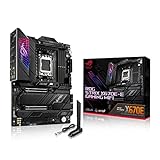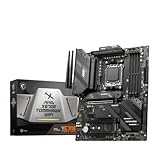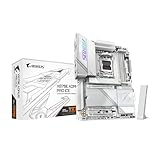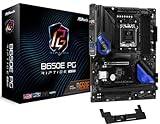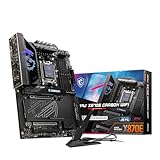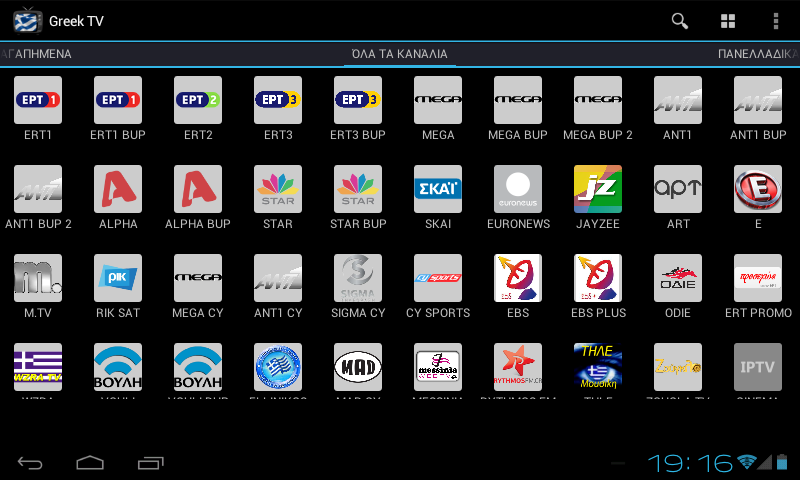AMD Ryzen 7 9800X3D is incredible, and I don’t think we need to post our gaming benchmarks again to prove this. That said, we still need to make sure the owners of Ryzen 9800X3D can leverage its full potential and there is no better way than to get a motherboard that can push it to its limits.
While it’s not entirely necessary to overclock the 9800X3D to achieve the pinnacle of the gaming experience, you would be limiting yourself to a CPU that is made for it. Whether you want to overclock it or not, it’s crucial to understand that the Ryzen 7 9800X3D needs to be fed stable power to maintain higher clock speeds.
Unlike previous X3D chips, the 9800X3D can achieve incredibly high clock speeds; therefore, strong power delivery is the need of the hour. However, you don’t have to spend $700 on a motherboard and can achieve this even on budget AM5 motherboards. Whether your budget is $200 or $500, we have a great pick for every price tag that will ensure the best performance and thermals outside the box.
A Quick Glance at the List
Things to Consider When Buying a Motherboard for AMD Ryzen 7 9800X3D
Overclocking support: It will be a huge disappointment if you miss the overclocking capabilities of the Ryzen 7 9800X3D. This is the first time AMD has unlocked the full OC potential of X3D chips and going with a motherboard with robust VRM should be a no-brainer. It’s recommended to look for a good number of power phases with big heatsinks for stable overclocking.
Cooling: Motherboards with large heatsinks will always help your system run cooler than those that have smaller ones. Apart from having well-grooved and dense heatsinks on the VRM, look for heatsinks on the M.2 slots and chipset as well. After taking care of the PCB cooling, look for how many fan and cooling headers you are getting. The motherboard should support at least 4-6 chassis fans and at least one AIO for supporting sufficient cooling devices.
Onboard Features: Onboard features include troubleshooting functions as well as additional stuff like EZ DIY design and headers for connectivity. Overclocking CPU and memory can sometimes lead to boot errors or malfunctions. This can be easily resolved with Debug LEDs, Error Code, and Clear CMOS button. To speed up this process, good motherboards are equipped with Power and Reset buttons as well, which let you do all the experiments quickly while your chassis side panel is open.
Budget: Decide how much you are willing to spend on the motherboard alone and secure the rest of the cash on other components. It’s always better to go with a better motherboard for easy upgrades, but keep in mind that the direct impact of a motherboard on gaming performance won’t be noticeable in most cases. Hence, even if you settle with the most basic chipset, you will be good for doing as long as you are deploying a decent cooling solution for the Ryzen 7 9800X3D.
Top Motherboard Picks for AMD Ryzen 7 9800X3D
Best Overall

Powerful, DIY-friendly, and beautiful: The X870E Taichi does everything to perfection and costs lower than its competitors from other vendors.
Chipset: X870E, VRM: 24+2+1, Memory Support: 256GB, 8200 MT/s, Storage: 4x M.2, 6x SATA, Connectivity: 5GbE LAN, WiFi 7, Bluetooth 5.4
| Pros | Cons |
| + Best thermals out of the box | – CMOS battery is under the heatsink |
| + Leading overclocking performance | – Somewhat expensive |
| + Plenty of onboard functions | |
| + Tons of connectivity features |
Out of all our tested X870/X870E motherboards, the ASRock X870E Taichi was way ahead of every model in most aspects. This was especially true in the VRM performance, which allowed Taichi to secure the number-one position. The X870E Taichi isn’t just the best option to go for the Ryzen 7 9800X3D, but is technically the best possible X870E motherboard for any AMD Ryzen 9000 processor, including the flagship Ryzen 9 9950X.
Through its solid 27-power phase VRM, coupled with dense and well-grooved heatsinks, the Taichi can sustain lower temperatures on both stock and OC modes, allowing users to harness their CPU’s potential to the max. So, you not only get higher clock speeds for higher performance but also less heat generation, which is ideal for longer operations at high clock speeds.
Thankfully, the Ryzen 7 9800X3D is fully unlocked, unlike its predecessors, making way to experiment more with the clocks to test its limits. Of course, this isn’t what the X870E Taichi brings to the table. Onboard troubleshooting features, excellent compatibility, modern connectivity, and EZ DIY design make it a perfect choice for modern high-end gaming builds.
Best Alternate

Sale
ASUS ROG Strix X670E-E
Chipset: X670E, VRM: 18+2+2, Memory Support: 192 GB, 8000 MT/s, Storage: 4x M.2, 6x SATA, Connectivity: 2.5 G LAN, WiFi 6E, Bluetooth 5.2
| Pros | Cons |
| + More affordable than the X870E counterpart | – Slightly downgraded compared to X870E counterpart |
| + Excellent power delivery and overclocking capabilities | |
| + Plethora of USB ports at rear I/O | |
| + Onboard troubleshooting options |
The X870E chipset isn’t the last option. It does offer slightly better specifications and memory support than the X670E, but the overall features are somewhat similar. This is why the ASUS ROG X670E-E is probably one of the best high-end boards for the Ryzen 7 9800X3D, which offers a competitive VRM with 22 power phases, decent connectivity, and plenty of onboard features.
Compared to the X870E-E, it is $60 cheaper and while it does bring slower wireless connectivity and no EZ DIY design, these things shouldn’t matter much if you are looking to just maximize the potential of the 9800X3D. We, anyway, have the X870E Taichi for $500, which is better than the X870E-E WiFi for the same price, which is why going with the X670E-E makes more sense as an alternative.
The ROG Strix X670E-E stands out at the rear I/O. There are only a handful of motherboards that are packed with so many USB ports. The motherboard brings a total of 12x USB 3.2 Gen 2 ports with Type A and Type C ports combined. Plus, there is a single USB 3.2 Gen2x2 USB Type C port for high-bandwidth devices as well. And if you want more, you can use the front panel headers, which include the Thunderbolt 4 port, and several USB 2.0 and 3.2 headers for the case front panel connectors.
Best High-End

MSI MPG X870E Carbon WiFi
Chipset: X870E, VRM: 18+2+1, Memory Support: 256 GB, 8400 MT/s, Storage: 4x M.2, 4x SATA, Connectivity: 5G and 2.5G LAN ports, WiFi 7, Bluetooth 5.4
| Pros | Cons |
| + 22 USB ports(front+rear) | – Not the best location for the Smart button at the rear I/O |
| + EZ Toolless design | – Somewhat expensive |
| + Distinguished VRM performance | |
| + Plenty of onboard features |
In the high-end category, there are plenty of competitive boards that make choosing the best one a bit difficult task. While there isn’t any “bad” motherboard, not every board will offer you the same number of specs and features, and it boils down to what offers you the most for the money. As far as the overall package is concerned, the MPG X870E Carbon WiFi nails it.
From offering a powerful VRM that keeps high temperatures at bay to incredible connectivity and aesthetics, the Carbon WiFi is one of the best high-end X870E boards to buy for Ryzen 9800X3D as well as other higher-end Zen 5 chips. In our testing, it came out to be the second-best board in thermals after ASRock X870E Taichi, thanks to its robust 21-power phase VRM.
But connectivity is unmatched. This is perhaps the only board on the list to feature dual LAN ports: 1x 5G and 1x 2.5G, along with WiFi 7 and Bluetooth 5.4. Furthermore, there are nearly two dozen USB ports for peripheral connectivity, which include both the rear I/O and front panel headers. At the rear I/O alone, there are 9x USB Type A 10G ports, 2x USB-C 40G, and 2x USB-C 10G ports.
The board is also decorated with beautiful heatsinks and RGB lighting on the I/O shroud and M.2 heatsink that can be customized via popular RGB software. For troubleshooting and stuff, there are EZ Debug, EZ Error Code, Power, and Reset buttons, and an additional PCI-E 8-pin connector at the bottom for supplying more power to the PCI-E x16 slots.
Best Mid-Range

Gigabyte X870E Aorus Pro ICE
Chipset: X870E, VRM: 16+2+2, Memory Support: 256 GB, 8200 MT/s, Storage: 4x M.2, 4x SATA, Connectivity: 2.5G LAN, WiFi 7, Bluetooth 5.3
| Pros | Cons |
| + Well-organized | – CMOS battery is under the heatsink |
| + EZ DIY-friendly design | |
| + Decent overclocking performance | |
| + Onboard troubleshooting features |
The X870E AORUS PRO ICE is a wonderful solution that neither breaks the bank nor compromises its functionality and features. Packed with brushed aluminum heatsinks over the VRM, chipset, and M.2 slots, it exudes a premium aesthetic that meets the versatile functionality of the board through the EZ DIY-friendly design.
You can simply add a WiFi antenna, an M.2, or a GPU with the EZ-Plug and Play functionality that makes life easier. Of course, you will receive a top-notch VRM for overclocking, big heatsinks with embedded copper heat pipes, and excellent connectivity. The board is well-organized regarding the headers and onboard features, separating the troubleshooting features on the top-right for easy access and grouping multiple fans, RGB/ARGB, and front panel headers for easier connection.
It’s the right choice for Ryzen 7 9800X3D to build a well-balanced gaming system, where you would be able to add almost any modern device without having to check compatibility, making upgrades easier down the line. However, if you are short on cash, consider the next options that will be close to ideal for 9800X3D as well.
Best Budget

Sale
MSI MAG X670E Tomahawk WiFi
Chipset: X670E, VRM: 14+2+1, Memory Support: 256 GB, 7800 MT/s, Storage: 4x M.2, 4x SATA, Connectivity: 2.5G LAN, WiFi 6E, Bluetooth 5.3
| Pros | Cons |
| + Very affordable | – Limited onboard troubleshooting options |
| + Native PCI-E Gen 5.0 support | – Downgraded connectivity compared to X870E |
| + EZ Debug LEDs | – Not ideal for strong overclocking |
| + Decent overclocking capabilities |
Users who don’t care about pushing the limits of Ryzen 9800X3D will find themselves content with MSI’s MAG X670E Tomahawk WiFi from the previous generation. It will be compatible with the 9800X3D outside the box with the latest AGESA BIOS update and has most of its features on par with modern motherboards, including the X870/X870E chipset.
There are some downgrades you should expect since WiFi 7, EZ DIY design, and higher memory support were introduced on the latest 800 chipsets, but if you take a look at its power delivery, component compatibility, and connectivity, they are perfect for any Ryzen 9000 CPU. You will be just fine with overclocking and stuff but don’t expect it to break records.
One of the major reasons to opt for this board is its significantly lower price compared to the X870E iteration. You will get many similar features on this one, which will ensure you can reach optimal performance outside the box. While it doesn’t have fancy onboard features, it does have the handy EZ Debug LEDs for troubleshooting basic hardware problems. Thankfully, with PCI-E 5.0 support, you will be able to add a next-gen GPU with a PCI-E 5.0 interface or any of the latest PCI-E 5.0 SSD to achieve high transfer speeds.
Best Entry-Level

ASRock B650E PG Riptide WiFi
Chipset: B650E, VRM: 14+2+1, Memory Support: 256 GB, 8200 MT/s, Storage: 4x M.2, 4x SATA, Connectivity: 2.5G LAN, WiFi 7, Bluetooth 5.3
| Pros | Cons |
| + Incredibly affordable | – Not suitable for intensive overclocking |
| + Can overclock both CPU and memory | – Several downgrades over X670 and X870 chipsets |
| + Has Debug LEDs | – Lackluster thermal performance |
| + Native PCI-E 5.0 support for GPU and M.2 | – Not much for troubleshooting |
One of the reasons why the Ryzen X3D processors stand out is because you can still have leading gaming performance even on the cheapest motherboards. While the B650E PG Riptide WiFi isn’t the cheapest AM5 motherboard, it surely is the most affordable one on this list with a price tag of less than $200. If you care about achieving the highest FPS per dollar, then this is for you.
The B650E chipset is fairly decent when it comes to modern PC hardware compatibility since you are getting native PCI-E 5.0 support. There are several tiers in the B650E motherboard lineup as well, but we believe that if you are paying over $200, it’s best to go with either the X670E or the X870E motherboards. Since this is for scaling down the overall expense to as minimal as possible while helping the 9800X3D achieve its full potential, you shouldn’t expect leading specs and features on this one.
You won’t get the best VRM, onboard features, connectivity, or aesthetics, but they are surely sufficient for most PC users, considering many of those modern specs are hardly utilized at the highest levels. The B650E Riptide Wi-Fi will save you quite a good amount of cash, allowing you to direct it into a better GPU or more RAM, which will have more impact on performance than getting a more expensive motherboard.
FAQ
Is it necessary to get an X870/X870E chipset for AMD Ryzen 7 9800X3D?
It’s not necessary to have the X870 or the X870E chipset motherboard to achieve the best performance with 9800X3D. Since the X670/X670E can do a similar job, you don’t have to spend more on the latest chipset except if you want WiFi 7, Bluetooth 5.4, and some additional stuff like EZ DIY design.
Is a high-end AM5 motherboard worth it for overclocking the Ryzen 7 9800X3D?
It depends on what you are seeking from the 9800X3D. If you aim to achieve the highest clock speed possible, then you should get the high-end X670E/X870E motherboards, but if you want stable performance while also having the freedom to overclock the 9800X3D a bit, you don’t need a high-end board.
Do I need support for a higher memory speed on AM5 motherboards?
Unfortunately, DDR5 memories struggle to reach high clock speeds on AM5 motherboards. The maximum memory clock support between 600 and 800 chipsets might seem significant in some cases, but you will hardly be able to get even close to the maximum supported frequency on 600 chipset motherboards, let alone the 800-chipset boards.
VIA: wccftech.com
AMD Ryzen 7 9800X3D is incredible, and I don’t think we need to post our gaming benchmarks again to prove this. That said, we still need to make sure the owners of Ryzen 9800X3D can leverage its full potential and there is no better way than to get a motherboard that can push it to its limits.
While it’s not entirely necessary to overclock the 9800X3D to achieve the pinnacle of the gaming experience, you would be limiting yourself to a CPU that is made for it. Whether you want to overclock it or not, it’s crucial to understand that the Ryzen 7 9800X3D needs to be fed stable power to maintain higher clock speeds.
Unlike previous X3D chips, the 9800X3D can achieve incredibly high clock speeds; therefore, strong power delivery is the need of the hour. However, you don’t have to spend $700 on a motherboard and can achieve this even on budget AM5 motherboards. Whether your budget is $200 or $500, we have a great pick for every price tag that will ensure the best performance and thermals outside the box.
A Quick Glance at the List
Things to Consider When Buying a Motherboard for AMD Ryzen 7 9800X3D
Overclocking support: It will be a huge disappointment if you miss the overclocking capabilities of the Ryzen 7 9800X3D. This is the first time AMD has unlocked the full OC potential of X3D chips and going with a motherboard with robust VRM should be a no-brainer. It’s recommended to look for a good number of power phases with big heatsinks for stable overclocking.
Cooling: Motherboards with large heatsinks will always help your system run cooler than those that have smaller ones. Apart from having well-grooved and dense heatsinks on the VRM, look for heatsinks on the M.2 slots and chipset as well. After taking care of the PCB cooling, look for how many fan and cooling headers you are getting. The motherboard should support at least 4-6 chassis fans and at least one AIO for supporting sufficient cooling devices.
Onboard Features: Onboard features include troubleshooting functions as well as additional stuff like EZ DIY design and headers for connectivity. Overclocking CPU and memory can sometimes lead to boot errors or malfunctions. This can be easily resolved with Debug LEDs, Error Code, and Clear CMOS button. To speed up this process, good motherboards are equipped with Power and Reset buttons as well, which let you do all the experiments quickly while your chassis side panel is open.
Budget: Decide how much you are willing to spend on the motherboard alone and secure the rest of the cash on other components. It’s always better to go with a better motherboard for easy upgrades, but keep in mind that the direct impact of a motherboard on gaming performance won’t be noticeable in most cases. Hence, even if you settle with the most basic chipset, you will be good for doing as long as you are deploying a decent cooling solution for the Ryzen 7 9800X3D.
Top Motherboard Picks for AMD Ryzen 7 9800X3D
Best Overall

Powerful, DIY-friendly, and beautiful: The X870E Taichi does everything to perfection and costs lower than its competitors from other vendors.
Chipset: X870E, VRM: 24+2+1, Memory Support: 256GB, 8200 MT/s, Storage: 4x M.2, 6x SATA, Connectivity: 5GbE LAN, WiFi 7, Bluetooth 5.4
| Pros | Cons |
| + Best thermals out of the box | – CMOS battery is under the heatsink |
| + Leading overclocking performance | – Somewhat expensive |
| + Plenty of onboard functions | |
| + Tons of connectivity features |
Out of all our tested X870/X870E motherboards, the ASRock X870E Taichi was way ahead of every model in most aspects. This was especially true in the VRM performance, which allowed Taichi to secure the number-one position. The X870E Taichi isn’t just the best option to go for the Ryzen 7 9800X3D, but is technically the best possible X870E motherboard for any AMD Ryzen 9000 processor, including the flagship Ryzen 9 9950X.
Through its solid 27-power phase VRM, coupled with dense and well-grooved heatsinks, the Taichi can sustain lower temperatures on both stock and OC modes, allowing users to harness their CPU’s potential to the max. So, you not only get higher clock speeds for higher performance but also less heat generation, which is ideal for longer operations at high clock speeds.
Thankfully, the Ryzen 7 9800X3D is fully unlocked, unlike its predecessors, making way to experiment more with the clocks to test its limits. Of course, this isn’t what the X870E Taichi brings to the table. Onboard troubleshooting features, excellent compatibility, modern connectivity, and EZ DIY design make it a perfect choice for modern high-end gaming builds.
Best Alternate

Sale
ASUS ROG Strix X670E-E
Chipset: X670E, VRM: 18+2+2, Memory Support: 192 GB, 8000 MT/s, Storage: 4x M.2, 6x SATA, Connectivity: 2.5 G LAN, WiFi 6E, Bluetooth 5.2
| Pros | Cons |
| + More affordable than the X870E counterpart | – Slightly downgraded compared to X870E counterpart |
| + Excellent power delivery and overclocking capabilities | |
| + Plethora of USB ports at rear I/O | |
| + Onboard troubleshooting options |
The X870E chipset isn’t the last option. It does offer slightly better specifications and memory support than the X670E, but the overall features are somewhat similar. This is why the ASUS ROG X670E-E is probably one of the best high-end boards for the Ryzen 7 9800X3D, which offers a competitive VRM with 22 power phases, decent connectivity, and plenty of onboard features.
Compared to the X870E-E, it is $60 cheaper and while it does bring slower wireless connectivity and no EZ DIY design, these things shouldn’t matter much if you are looking to just maximize the potential of the 9800X3D. We, anyway, have the X870E Taichi for $500, which is better than the X870E-E WiFi for the same price, which is why going with the X670E-E makes more sense as an alternative.
The ROG Strix X670E-E stands out at the rear I/O. There are only a handful of motherboards that are packed with so many USB ports. The motherboard brings a total of 12x USB 3.2 Gen 2 ports with Type A and Type C ports combined. Plus, there is a single USB 3.2 Gen2x2 USB Type C port for high-bandwidth devices as well. And if you want more, you can use the front panel headers, which include the Thunderbolt 4 port, and several USB 2.0 and 3.2 headers for the case front panel connectors.
Best High-End

MSI MPG X870E Carbon WiFi
Chipset: X870E, VRM: 18+2+1, Memory Support: 256 GB, 8400 MT/s, Storage: 4x M.2, 4x SATA, Connectivity: 5G and 2.5G LAN ports, WiFi 7, Bluetooth 5.4
| Pros | Cons |
| + 22 USB ports(front+rear) | – Not the best location for the Smart button at the rear I/O |
| + EZ Toolless design | – Somewhat expensive |
| + Distinguished VRM performance | |
| + Plenty of onboard features |
In the high-end category, there are plenty of competitive boards that make choosing the best one a bit difficult task. While there isn’t any “bad” motherboard, not every board will offer you the same number of specs and features, and it boils down to what offers you the most for the money. As far as the overall package is concerned, the MPG X870E Carbon WiFi nails it.
From offering a powerful VRM that keeps high temperatures at bay to incredible connectivity and aesthetics, the Carbon WiFi is one of the best high-end X870E boards to buy for Ryzen 9800X3D as well as other higher-end Zen 5 chips. In our testing, it came out to be the second-best board in thermals after ASRock X870E Taichi, thanks to its robust 21-power phase VRM.
But connectivity is unmatched. This is perhaps the only board on the list to feature dual LAN ports: 1x 5G and 1x 2.5G, along with WiFi 7 and Bluetooth 5.4. Furthermore, there are nearly two dozen USB ports for peripheral connectivity, which include both the rear I/O and front panel headers. At the rear I/O alone, there are 9x USB Type A 10G ports, 2x USB-C 40G, and 2x USB-C 10G ports.
The board is also decorated with beautiful heatsinks and RGB lighting on the I/O shroud and M.2 heatsink that can be customized via popular RGB software. For troubleshooting and stuff, there are EZ Debug, EZ Error Code, Power, and Reset buttons, and an additional PCI-E 8-pin connector at the bottom for supplying more power to the PCI-E x16 slots.
Best Mid-Range

Gigabyte X870E Aorus Pro ICE
Chipset: X870E, VRM: 16+2+2, Memory Support: 256 GB, 8200 MT/s, Storage: 4x M.2, 4x SATA, Connectivity: 2.5G LAN, WiFi 7, Bluetooth 5.3
| Pros | Cons |
| + Well-organized | – CMOS battery is under the heatsink |
| + EZ DIY-friendly design | |
| + Decent overclocking performance | |
| + Onboard troubleshooting features |
The X870E AORUS PRO ICE is a wonderful solution that neither breaks the bank nor compromises its functionality and features. Packed with brushed aluminum heatsinks over the VRM, chipset, and M.2 slots, it exudes a premium aesthetic that meets the versatile functionality of the board through the EZ DIY-friendly design.
You can simply add a WiFi antenna, an M.2, or a GPU with the EZ-Plug and Play functionality that makes life easier. Of course, you will receive a top-notch VRM for overclocking, big heatsinks with embedded copper heat pipes, and excellent connectivity. The board is well-organized regarding the headers and onboard features, separating the troubleshooting features on the top-right for easy access and grouping multiple fans, RGB/ARGB, and front panel headers for easier connection.
It’s the right choice for Ryzen 7 9800X3D to build a well-balanced gaming system, where you would be able to add almost any modern device without having to check compatibility, making upgrades easier down the line. However, if you are short on cash, consider the next options that will be close to ideal for 9800X3D as well.
Best Budget

Sale
MSI MAG X670E Tomahawk WiFi
Chipset: X670E, VRM: 14+2+1, Memory Support: 256 GB, 7800 MT/s, Storage: 4x M.2, 4x SATA, Connectivity: 2.5G LAN, WiFi 6E, Bluetooth 5.3
| Pros | Cons |
| + Very affordable | – Limited onboard troubleshooting options |
| + Native PCI-E Gen 5.0 support | – Downgraded connectivity compared to X870E |
| + EZ Debug LEDs | – Not ideal for strong overclocking |
| + Decent overclocking capabilities |
Users who don’t care about pushing the limits of Ryzen 9800X3D will find themselves content with MSI’s MAG X670E Tomahawk WiFi from the previous generation. It will be compatible with the 9800X3D outside the box with the latest AGESA BIOS update and has most of its features on par with modern motherboards, including the X870/X870E chipset.
There are some downgrades you should expect since WiFi 7, EZ DIY design, and higher memory support were introduced on the latest 800 chipsets, but if you take a look at its power delivery, component compatibility, and connectivity, they are perfect for any Ryzen 9000 CPU. You will be just fine with overclocking and stuff but don’t expect it to break records.
One of the major reasons to opt for this board is its significantly lower price compared to the X870E iteration. You will get many similar features on this one, which will ensure you can reach optimal performance outside the box. While it doesn’t have fancy onboard features, it does have the handy EZ Debug LEDs for troubleshooting basic hardware problems. Thankfully, with PCI-E 5.0 support, you will be able to add a next-gen GPU with a PCI-E 5.0 interface or any of the latest PCI-E 5.0 SSD to achieve high transfer speeds.
Best Entry-Level

ASRock B650E PG Riptide WiFi
Chipset: B650E, VRM: 14+2+1, Memory Support: 256 GB, 8200 MT/s, Storage: 4x M.2, 4x SATA, Connectivity: 2.5G LAN, WiFi 7, Bluetooth 5.3
| Pros | Cons |
| + Incredibly affordable | – Not suitable for intensive overclocking |
| + Can overclock both CPU and memory | – Several downgrades over X670 and X870 chipsets |
| + Has Debug LEDs | – Lackluster thermal performance |
| + Native PCI-E 5.0 support for GPU and M.2 | – Not much for troubleshooting |
One of the reasons why the Ryzen X3D processors stand out is because you can still have leading gaming performance even on the cheapest motherboards. While the B650E PG Riptide WiFi isn’t the cheapest AM5 motherboard, it surely is the most affordable one on this list with a price tag of less than $200. If you care about achieving the highest FPS per dollar, then this is for you.
The B650E chipset is fairly decent when it comes to modern PC hardware compatibility since you are getting native PCI-E 5.0 support. There are several tiers in the B650E motherboard lineup as well, but we believe that if you are paying over $200, it’s best to go with either the X670E or the X870E motherboards. Since this is for scaling down the overall expense to as minimal as possible while helping the 9800X3D achieve its full potential, you shouldn’t expect leading specs and features on this one.
You won’t get the best VRM, onboard features, connectivity, or aesthetics, but they are surely sufficient for most PC users, considering many of those modern specs are hardly utilized at the highest levels. The B650E Riptide Wi-Fi will save you quite a good amount of cash, allowing you to direct it into a better GPU or more RAM, which will have more impact on performance than getting a more expensive motherboard.
FAQ
Is it necessary to get an X870/X870E chipset for AMD Ryzen 7 9800X3D?
It’s not necessary to have the X870 or the X870E chipset motherboard to achieve the best performance with 9800X3D. Since the X670/X670E can do a similar job, you don’t have to spend more on the latest chipset except if you want WiFi 7, Bluetooth 5.4, and some additional stuff like EZ DIY design.
Is a high-end AM5 motherboard worth it for overclocking the Ryzen 7 9800X3D?
It depends on what you are seeking from the 9800X3D. If you aim to achieve the highest clock speed possible, then you should get the high-end X670E/X870E motherboards, but if you want stable performance while also having the freedom to overclock the 9800X3D a bit, you don’t need a high-end board.
Do I need support for a higher memory speed on AM5 motherboards?
Unfortunately, DDR5 memories struggle to reach high clock speeds on AM5 motherboards. The maximum memory clock support between 600 and 800 chipsets might seem significant in some cases, but you will hardly be able to get even close to the maximum supported frequency on 600 chipset motherboards, let alone the 800-chipset boards.
VIA: Πηγή Άρθρου
Greek Live Channels Όλα τα Ελληνικά κανάλια: Βρίσκεστε μακριά από το σπίτι ή δεν έχετε πρόσβαση σε τηλεόραση; Το IPTV σας επιτρέπει να παρακολουθείτε όλα τα Ελληνικά κανάλια και άλλο περιεχόμενο από οποιαδήποτε συσκευή συνδεδεμένη στο διαδίκτυο. Αν θες πρόσβαση σε όλα τα Ελληνικά κανάλια Πατήστε Εδώ
Ακολουθήστε το TechFreak.GR στο Google News για να μάθετε πρώτοι όλες τις ειδήσεις τεχνολογίας.


